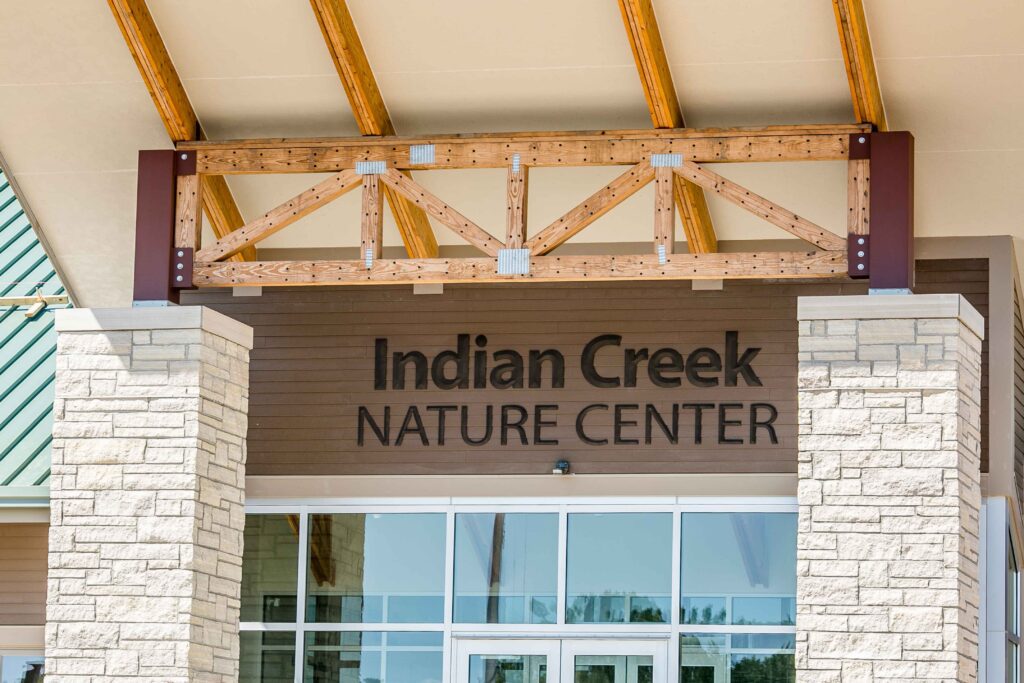Disclaimer: The sustainability practices shared in this post are in no way meant to shame or wag a finger at anyone not replicating these sustainability practices. Indian Creek Nature Center recognizes the world is not currently set up to make sustainable living choices easy and that every person or organization has varying levels of resources they can direct to waste reduction and other ways to live more sustainably. ICNC hopes to model these approaches without placing any judgment on others. Our hope is that we can offer tools for others, so that when someone is ready they can begin their own journey to a more sustainable life.
When it comes to sustainability, waste is one of the biggest challenges, especially for a building with as many people coming and going as Amazing Space.
From its conception, the Amazing Space building was designed to showcase how sustainable living and construction practices are attainable. While the construction of the building earned it Living Building Challenge petal certification (making Amazing Space one of only 31 in the world at that time), the people using the building must find ways to bring these sustainability practices to life.
Reduce
Step one in any attempt to limit the amount of waste created is to reduce what you use in the first place.
Amazing Space was created with this in mind, which is why our bathrooms have efficient hand dryers. Removing the option of paper towels reduces the use of paper and instead relies on a small amount of renewably-sourced electricity for hand drying.
This approach extends to our lights and windows, as well. Lights in the meeting rooms and parking lot have sensors that will dim or turn off the lights when not needed. There has also been a system installed that compares the atmosphere inside and outside the building to alert staff when opening the windows is energy efficient. If you are ever walking through Amazing Space and see a small green light on our wall, it means conditions are right for opening windows and letting in some fresh air.
Another major way we reduce waste is by composting as much as we can. You may notice small green bins throughout the building. ICNC partners with a local company, Compost Ninja, that takes all our compostable materials placed in those green bins and turns them into valuable compost for growing new life instead of going to a landfill. Composting is also a valuable tool for reducing waste when we host large events, like the Maple Syrup Festival. Feeding hundreds of people breakfast could create a lot of waste, which is why we only use compostable plates, forks, knives and napkins at this event. After guests have enjoyed their last few bites of pancake, their plates (non-meat food scraps and all) can get composted instead of being tossed in the garbage.
Reuse
When we can’t reduce, we reuse.
This can mean things as simple as leaving a date off a yard sign announcing our events so it can be used year-after-year; putting rechargeable batteries in our soap dispensers; having a refillable water station outside our bathrooms to encourage people to reuse water bottles; and selling reusable items and sustainably-sourced items in our Creekside Shop.
These day-to-day methods all help, but when events bring large numbers to Amazing Space, often to eat, we need other ways to limit our collective waste. Culinary events, such as our Farm to Table Dinners, use cloth napkins, ceramic plates and silverware that can all be washed on site using renewably-sourced water and electricity. When adult beverages are called for, we use a kegerator, which eliminates the need for boxes and boxes of cans.
Also, we sell used items at Nature’s Noel and the Spring Plant & Art Sale. At these events shoppers can give an item a second life while keeping it out of the landfill.
Recycle
When we can’t eliminate waste or reuse objects, we strive to recycle what we can.
One trick for recycling more is asking others to be mindful of what they use. That’s why we require that renters avoid using styrofoam during their visit. This encourages them to use more sustainable options.
Another way we aim to recycle more and encourage others, as well, is to be mindful of what and how we print. When we print anything (whether it’s a trail map or an Annual Report) we make sure we’re using recyclable paper at a minimum, and preferably recycled or sustainably-sourced paper.
Lastly, a small step that can make a big difference is the garbage bins placed around the Amazing Space campus. In our offices, each desk has a small garbage can with a larger recycling bin attached to it — reminding staff that we should be recycling first and using the garbage bin second.
Larger garbage bins for public use throughout the building are paired with a recycling bin and compost bin. These are labeled with examples of what should go in each. Not only can this reduce waste in Amazing Space, but it can also help visitors learn what they may be able to recycle or compost in their own homes or places of business.

